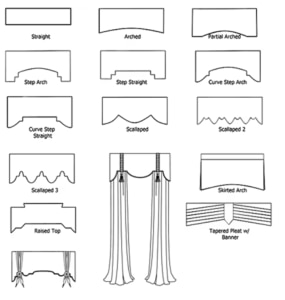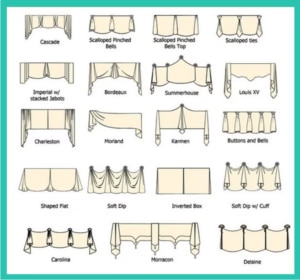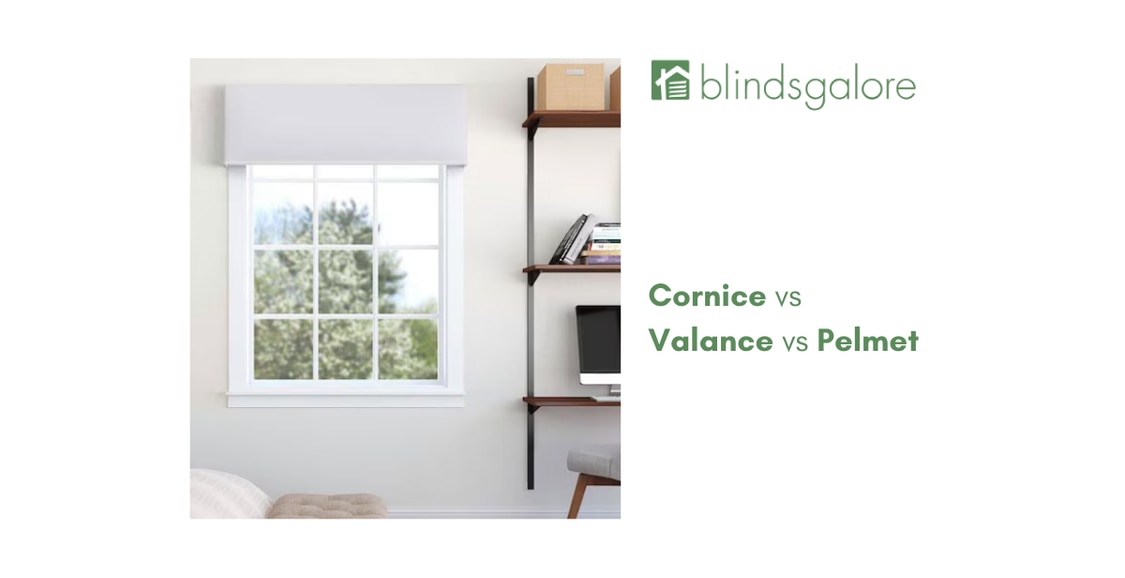Standing in front of bare windows feels wrong. Like a painting without a frame. You know you need something at the top, but what exactly? Cornices, valances, and pelmets keep popping up in your search, but honestly, what’s the difference?
At Blindsgalore, we’ve been helping families crown their windows for over 25 years. Our customers ask about these formal window toppers daily. Some call them cornices. Others say valances. British friends mention pelmets. The confusion is real, but we’re here to clear it up.
Here’s the bottom line: each option brings something different to your windows. One offers crisp, architectural lines. Another adds soft, flowing romance. The third? Well, that depends on who’s talking. Let’s break down these architectural window treatments so you can pick the perfect one for your home.
What Is the Difference Between a Cornice, Valance, and Pelmet in Interior Design?
A cornice is that rigid, box-like structure sitting proudly above your window. Picture a wooden frame, usually wrapped in fabric or painted, creating a tailored finish. We craft ours from sturdy materials like wood or MDF. The shape stays firm, the look stays polished. No drooping, no sagging, just clean architectural beauty.

A valance takes the soft approach entirely. Pure fabric hanging loosely across your window top. No rigid backing whatsoever. Think gathered styles that puddle gracefully, pleated designs with perfect folds, or simple scarves draped across a rod. Romantic, changeable, and oh-so-soft to touch.

Now about pelmets. Here’s where geography matters. In British English, “pelmet” covers both rigid structures (like cornices) and soft treatments (like valances). Americans typically say “cornice” for the hard box and “valance” for the soft fabric. Same products, different words. Like lift and elevator, or biscuit and cookie.
At Blindsgalore, we stick with “cornice” and “valance” because that’s what most customers search for. But if your British neighbor mentions pelmets, she’s not speaking gibberish. She’s just using different vocabulary for the same window treatments.
Want to see the difference in action? Check out our detailed comparison guide that shows real examples of each style.
What Is a Valance Used for vs a Cornice?
Valances serve multiple purposes, all while looking pretty:
- Hide curtain rods and hardware (though not as completely as cornices)
- Add decorative flair without breaking the bank
- Create visual height when mounted high
- Soften hard window lines
- Allow seasonal updates easily
Perfect for renters who can’t drill permanent fixtures. Great for kids’ rooms where washing is necessary. Wonderful for casual spaces needing approachable charm.
Structured window coverings like cornices work harder:
- Completely conceal all hardware and mechanisms
- Block light gaps at window tops
- Add architectural weight to rooms
- Provide better insulation
- Create that built-in, custom look
- Last for decades with minimal care
Our Blindsgalore Cornice Boards: Tailored collection shows exactly what structured toppers can do. Clean lines hiding every bracket and screw. Your guests see elegance, not mechanics.
Is a Pelmet the Same as a Cornice in the US?
Not quite, but almost. In American English, we rarely use “pelmet.” We say “cornice” for rigid window toppers and “valance” for soft ones. Clear and simple.
The word “pelmet” traveled from France through Britain, picking up meanings along the way. “Cornice” has classical architectural roots, coming from the decorative molding atop Greek columns. Americans adopted the architectural term, Brits kept the French one.
Some interior designers claim subtle differences exist. Maybe pelmets run slightly narrower. Perhaps cornices feel more substantial. Honestly? In today’s market, they’re interchangeable terms for the same rigid window topper.
Our Modern cornice boards work perfectly whether you call them cornices, pelmets, or “those boxy things above windows.” Function stays identical regardless of terminology.
What Are the American English Terms for Pelmet Window Treatment?
Americans keep it simple:
- Cornice or Cornice Board: The rigid, structured box
- Valance: The soft, fabric treatment
- Window Topper: General term for anything decorative above windows
- Box Valance: Sometimes used for fabric-covered rigid structures
Walk into any American home improvement store asking for pelmets, and you’ll get blank stares. Say “cornice boards” and suddenly everyone knows exactly what you need. We’ve learned to translate between American and British window treatment vocabulary after 25 years helping international customers.
Which Are Better for Soft vs Hard Window Treatments?
Hard treatment comparison shows clear winners for different needs.
Soft treatments (valances) excel when you want:
- Easy washing and maintenance
- Seasonal style changes
- Romantic, flowing aesthetics
- Budget-friendly options
- Rental-friendly installation
Hard treatments (cornices) dominate when you need:
- Complete hardware concealment
- Architectural presence
- Long-lasting durability
- Better light blocking
- Professional, polished appearance
Think about your lifestyle. Got messy kids? Soft valances toss in the washing machine. Formal dining room? Hard cornices bring gravitas. Master bedroom? Either works, depending on your style preference.
When Should You Choose a Valance vs a Cornice for Window Toppers?
Room purpose guides your choice beautifully.
Choose valances for:
- Children’s bedrooms (easy washing!)
- Breakfast nooks and casual dining
- Kitchens with light cooking
- Rental properties
- Spaces you redecorate frequently
Choose cornices for:
- Formal living and dining rooms
- Home offices and studies
- Master bedrooms
- Media rooms needing light control
- Anywhere you want that custom, built-in look
Our Arched cornice boards bring elegance to formal spaces. The gentle curve softens strict lines while maintaining structure. Perfect for traditional homes wanting architectural detail.
Which Window Treatment Conceals Curtain Hardware Best?
Cornices win this battle without question. That rigid box completely hides everything. Brackets, screws, mechanisms, cords. All tucked away behind beautiful fabric or painted wood. Your windows look effortlessly elegant.
Valances try their best, but soft fabric shifts. Breezes make them flutter. Suddenly that curtain rod peeks through. Fine for casual spaces where perfection doesn’t matter. Frustrating in formal rooms where every detail counts.
Here’s what many folks miss: cornices also protect hardware from dust and damage. Less cleaning for you. Longer life for expensive curtain rods and mechanisms. We’ve seen covered hardware last 20+ years while exposed pieces need replacing within 5-10.
How Do Formal vs Informal Window Treatments Compare?
Formal window toppers like cornices signal sophistication. The structured appearance complements quality furniture. Clean lines echo fine dining sets. Architectural weight matches formal decor perfectly.
In our showroom, we notice how cornices instantly elevate room formality. Same windows, same curtains, add a cornice? Suddenly the space feels more refined. Like wearing a blazer versus a t-shirt.
Valances lean casual by nature. That soft drape says “relax here.” Perfect for family rooms where kids sprawl on sofas. Wonderful in bedrooms promoting rest. Charming in kitchens where approachable comfort matters most.
But here’s our secret: fabric choice swings either direction. Velvet cornices scream formality. Cotton valances whisper casual. Linen on either creates relaxed elegance. Material matters as much as structure.
What Is the Best Window Treatment for Casual Spaces?
Casual spaces love valances. Soft, approachable, changeable. Just like the rooms they decorate.
In my own breakfast nook, I swap valances seasonally. Light cotton for summer, cozy plaid for winter. It takes 10 minutes to change the whole room’s mood. Can’t do that with rigid cornices.
For ultimate casual comfort, try:
- Gathered valances in washable cotton
- Tab-top styles for easy removal
- Relaxed pleats that don’t require perfection
- Natural textures like burlap or linen
Pair valances with our cordless blinds for function plus casual style. The blinds handle privacy and light control. The valance adds that decorative touch making windows feel dressed, not naked.
Which Architectural Window Treatments Enhance Insulation?
Cornices provide surprising insulation benefits. That rigid box creates dead air space above your window. Cold air stays trapped there instead of flowing into your room. Same principle as double-pane windows, just at the top.
Combined with cellular shades, cornices create serious energy efficiency. The shades insulate the window surface. The cornice blocks drafts from above. Your heating and cooling bills thank you.
Valances? Pretty but not particularly insulating. Soft fabric moves with air currents rather than blocking them. Fine for mild climates or well-sealed windows. Not ideal for drafty older homes needing every efficiency boost.
We’ve had customers report noticeable temperature differences after adding cornices. One customer in Minnesota said her bedroom stayed 3-4 degrees warmer in winter. Small change, big comfort improvement.
What Materials Are Used for Cornices vs Valances vs Pelmets?
Cornices typically start with:
- Wood frames for traditional strength
- MDF for smooth, paintable surfaces
- Lightweight foam boards for easy installation
- Metal frames for industrial aesthetics
Then we cover them with:
- Designer fabrics matching your decor
- Paint for seamless wall integration
- Wallpaper for pattern play
- Even leather for unique texture
Valances use flowing materials:
- Cotton for easy care
- Linen for natural texture
- Silk for formal elegance
- Polyester blends for durability
- Sheer fabrics for light filtering
Remember, never submerge any window treatment in water for cleaning. Not cornices, not valances, nothing. Water ruins internal structures and causes warping. Spot clean only, always.
What Are the Best Cornice Valance Pelmet Styles for Different Room Aesthetics?
- Modern minimalist rooms: Our Tailored cornice boards in solid neutrals. Clean lines matching your aesthetic. No fussy details.
- Traditional spaces: Arched cornices bring classic appeal. Gentle curves honor architectural heritage. Rich fabrics add appropriate weight.
- Transitional styles: Structured cornices in relaxed fabrics. Maybe a boxy cornice covered in nubby linen. Formal structure, casual texture. Best of both worlds.
- Farmhouse charm: Simple wooden cornices, painted or distressed. Or gathered valances in ticking stripes. That homespun feeling without looking costume-y.
Mix and match works too. Layer a soft valance under a structured cornice. Use cornices in formal areas, valances in casual spaces. Your home, your rules.
How Difficult Is DIY Installation for Valances vs Cornices?
Here at Blindsgalore, 99% of our customers install their own window treatments successfully. Both Window valances and cornices arrive with everything needed for DIY triumph.
Valance installation:
- Mount a simple rod or board (15 minutes)
- Slide or clip fabric in place (5 minutes)
- Adjust for even hanging (5 minutes)
- Stand back and admire (priceless)
Most valances need just a screwdriver and level. Even first-timers succeed. Change them seasonally without stress.
Cornice installation:
- Locate wall studs for security (10 minutes)
- Mark bracket positions carefully (10 minutes)
- Pre-drill and mount brackets (20 minutes)
- Clip cornice onto brackets (5 minutes)
Basic tools handle the job: drill, level, screwdriver, measuring tape. About an hour total. No guessing, no stressing! We include detailed instructions. Our help center has videos. Our experts answer questions at (877) 702-5463.
What About Maintenance and Cleaning Differences Between Valances and Cornices?
Valances offer easy maintenance:
- Remove and wash as needed
- Many machine washable options
- Iron or steam to refresh
- Replace when styles change
The downside? Frequent handling wears fabrics. Washing might cause shrinking. But overall, maintenance stays simple.
Cornices need different care:
- Dust with microfiber cloths monthly
- Vacuum with upholstery attachment
- Spot clean carefully with damp cloth
- Never submerge in water (ruins everything!)
The upside? Cornices need less frequent attention. Fixed position means less dirt accumulation. No weekly washing marathons.
In our experience, busy families often prefer cornices for low maintenance. Empty nesters might enjoy changing valances seasonally. Match maintenance to your lifestyle.
What Are the Cost Differences Between Valances and Cornices?
Let’s talk about investment levels honestly. All our products are custom made, so prices vary based on size and options. But generally:
Valances cost less because:
- Less material needed
- Simpler construction
- DIY-friendly reduces labor
- Easy to find fabric remnants
Cornices represent larger investment because:
- Custom framework construction
- Professional upholstering or finishing
- Built to last decades
- Precision crafting required
Consider long-term value though. Valances might need replacing every few years. Styles change, fabric fades. Cornices? We’ve seen ours looking perfect after 20+ years. One investment, decades of beauty.
Our free 3-year warranty (upgradeable to 5 years) protects your investment. Free exchanges within 30 days for any reason, covering up to four windows per household. Industry’s best guarantee because we believe in our craftsmanship.
Can You Combine Valances, Cornices, and Pelmets in One Window Treatment?
Absolutely! Layering creates designer-level sophistication.
Winning combinations:
- Cornice + sheer valance = structure plus softness
- Cornice + drapery panels = classic elegance
- Valance + Roman shades = pattern play
In my daughter’s room, we layered a pink cornice over white sheer valance. The cornice hides hardware while the valance adds fairy-tale softness. She loves how it frames her reading nook window.
Keep proportions balanced. Don’t overwhelm windows with too many layers. Each element should serve a purpose: hardware hiding, light softening, or pure decoration.
How Do You Decorate With Valances vs Cornices for Different Window Types?
Standard windows: Either option works beautifully. Cornices add height to small windows. Valances bring width to narrow ones.
Wide windows: Cornices maintain structure across any span. Extra-wide valances need center support to prevent sagging.
Bay windows: Cornices unify all angles perfectly. One continuous cornice creates cohesion. Valances might look disconnected between sections.
Arched windows: Our Arched cornices follow curves beautifully. Straight valances look awkward over arches.
Match your topper to window architecture. Fighting the window’s natural shape never works. Embrace what you have, enhance, don’t hide.
Do Valances or Cornices Require Professional Installation?
Never! Well, almost never. At Blindsgalore, we empower DIY success.
Both valances and cornices arrive with:
- All mounting hardware
- Step-by-step instructions with pictures
- Access to installation videos
- Phone support from real experts
Skip expensive installation services. Save that money for more window treatments! Most folks finish installation while their coffee’s still warm. You’ve got this.
The only time we’d suggest help? Maybe extremely high windows where ladder work feels unsafe. Otherwise, grab your drill and go for it. Join the 99% of customers who DIY successfully.
Making Your Window Topper Choice Count
Now you understand the cornice valance pelmet differences clearly. Hard treatment comparison shows cornices bring structure and permanence. Soft valances offer flexibility and romance. Pelmets? Just British vocabulary for the same things.
At Blindsgalore, our family has helped families like yours for over 25 years. Whether you choose structured window coverings or soft toppers, we craft each piece specifically for your windows. No mass production here. Just beautiful window treatments made with care.
Ready to crown your windows perfectly? Order up to 15 free samples to touch and feel your options. Call our experts at (877) 702-5463 for personalized help. With free shipping across the continental U.S. and products ready in 5-7 business days, your perfect window toppers are just days away.
Your windows work hard for your home. Time to give them the royal treatment they deserve.
Frequently Asked Questions
Fabric and lining can react to moisture. Choose moisture-resistant/performance fabrics from our collection and ensure good ventilation. Spot-clean only—never saturate or submerge any window treatment.
Our cornices are wall-mounted. Check your lease before drilling. Installation typically requires a few screws/anchors; small holes can be patched at move-out. If you can’t drill, consider a fabric valance instead.
Order fabric swatches (we offer 144 options) to coordinate with your blind color/texture. For sizing, choose a custom width that extends about 2–3 inches past the blind on each side. Ensure enough depth to clear the blind headrail and brackets.
We offer 12″ and 16″ drops. As a guide: use 12″ for most standard windows; choose 16″ for taller windows or higher ceilings. Pick the proportion that looks balanced in your space.
Yes. Cornices neatly conceal motors and wiring—just allow adequate inner clearance for movement. We’ll help you confirm the right width and drop (12″ or 16″) during sizing.

